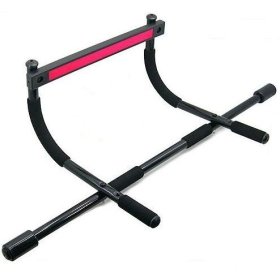I recently made my own gravity boots using parts that can be found at your local hardware or home improvement store. I have some coworkers with severe back problems who have shown significant improvements while using inversion therapy. So I wanted to try it out for myself, but I didn’t want to invest hundreds of dollars in the equipment without knowing whether or not inversion therapy would even work for me. My solution … make my own to try out before buying.
Theory
The theory behind inversion therapy (http://en.wikipedia.org/wiki/Inversion_therapy) is that it uncompresses the soft disks in your spine and allows moisture back into them. Other touted benefits are improved posture and improved circulation & oxygen to the brain. Critics of inversion therapy suggest that the touted benefits are not real and have not been proven. Critics also maintain that inversion therapy is dangerous because of the risk of falling and also the danger imposed by the increase in blood pressure in the head and eyes.
Disclaimer
I must insist that nobody try making their own gravity boots at home. If you fall on your head, you could get seriously injured and I cannot be held liable. Even if you don’t fall on your head, there are other physical and physiological dangers involved, so again, please do not try this at home.
Products
I looked at the Teeter Hang Ups gravity boots to get an idea of how these things were designed (see photo). This appears to be a very popular brand, according to Google search. These boots appear to be a pretty simple design just from looking at the photos. They appear to be basically a piece of plastic around your calves with a heavy duty hook attached to the plastic and foam for cushioning and buckles that tighten similar to roller blade or ski boot buckles.
.
Trials
I own a typical door frame pull up bar that I’ve had for eons (see photo), so I thought I could use this pull up bar to hang upside down from. I just needed some boots to strap around my ankles with a heavy duty hook attached securely to the boots.
. 
I tried making these gravity boots three different ways before I finally got it right. My first attempt used denim from an old pair of jeans to wrap around my calves with some utility hooks bolted through the denim (see photo).
. 
I wrapped a hand towel around my calves first for cushioning and then the denim contraption around that and tied the denim ends together in a knot as tightly as I could. It felt fairly strong, but when I carefully let more and more of my weight on it while hanging from the pull up bar, the denim started to tear. Not strong enough. Now I can see why they used plastic on the commercial product. Denim is tough, but not strong enough to hold my weight.
So for my second attempt, I used the plastic from an old mop bucket that was laying around the garage and I bolted the same utility hooks onto this plastic and wrapped it around my legs … also around a towel for cushioning. I don’t have a photo of this configuration because I tore it up and used the plastic for something else before taking a photo.
This configuration was definitely stronger than the denim, but the plastic torqued enough when I tried to put my full weight on it, that I didn’t feel good about the situation. I decided that these particular utility hooks had too large of a radius which was making them rotate away from my calves instead of just pulling straight up along the plastic bucket surface. I decided that I needed a smaller radius hook that was also very strong. So I went shopping at my local Lowe’s home improvement store.
I found these heavy duty utility J-hooks (see photo) at Lowe’s. They are made by Tornado and they are small yet very strong. I also bought some nice big bolts to attach the hooks with and I also bought a 5 gallon bucket to use as the base plastic. I also bought some squishy foam matting … the kind that cashiers stand on all day to cushion their feet.
. 
I had some 2-inch wide strips of Velcro laying around that I used to strap the boots tightly around my calves. The Velcro holds very well when it has lots of surface area all the way around the whole boot to attach to. You can see one of my fully assembled gravity boots in the photo below.
. 
Getting them closed tightly enough to not immediately slip and pull on my ankles took lots of trial and error, but I’ve got a system now that seems to work pretty well. I decided that the rubberized foam matting that I bought at Lowe’s was too stiff and not really helping to hold on to my calves, so I bought some light pillow foam at WalMart and I wrap that around my calves first and then put the gravity boots on over that and the combination seems to work pretty well at holding onto my calves without allowing too much slippage. Below is a photo of me using my home made gravity boots.
. 
When I first started using these home made gravity boots, I could only stand to be upside down for about 5 minutes at a time. After a few days I could do 10 minutes, then after a few weeks I could do 15 minutes. Usually what keeps me from hanging longer is that my legs or feet go to sleep and then start to hurt. So I’m wondering if the commercial gravity boots are able to hold on to your calves tightly enough to not slip, but without cutting off your circulation. Seems like a fine line to me. Maybe the key is using the right kind of foam that can grip your calves without having to be too tight.
Conclusion
Do they work? Do they help my lower back pain? Well, kind of. That’s the best answer I can give right now. I’ve only been using inversion therapy for a couple of weeks so far, and I haven’t been able to do it as regularly as I’d like. But sometimes after hanging upside down I can tell that my back pain has immediately stopped. Other times, I don’t notice any difference at all. So I don’t have any significant and repeatable short term results to share, but I’m going to try it long term and see if I can notice a long term difference in my lower back pain.
Thanks for reading. If you have any comments or questions on this article, please be my guest. Article comments can be read by anyone on the Internet, so if you’d rather send me a private message, just email me directly.
Kurt
Update: Click on the “ad” below to buy the Teeter brand Hang Ups gravity boots on Amazon.com:










 .
. 

